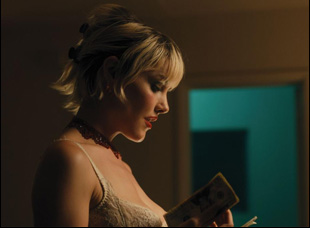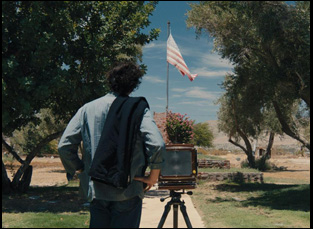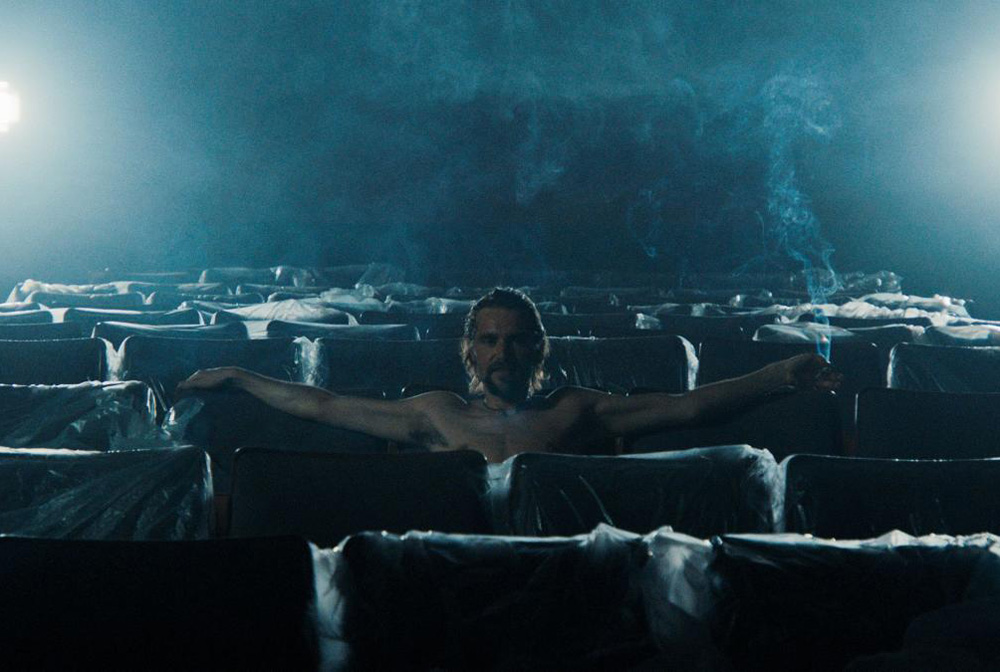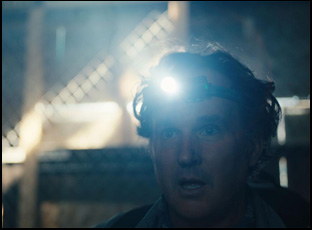Joshua Erkman doesn’t waste his time making a statement in “A Desert” as a man walks around an abandoned multiplex that’s seen better days, with the promise of coming attractions acting as something of a mirage. As the drifter who comes to be known as Renny (Zachary Ray Sherman) into a seat in the theater whereas the rows are shrouded in plastic, the time to watch movies seems to have come and gone when what was once a cathedral to cinema now simply looks like sitting in the middle of nowhere, but the striking introduction marks the start of the director shaking the dust off the medium with a twisty noir.
In his longtime work in film restoration, Erkman has surely seen it all, making his feature debut far more slippery to describe, though it primarily concerns a photographer named Alex (Kai Lennox), who is drawn towards shooting the people and places that society has left behind, perhaps feeling a little that way himself when it seems like he’s gotten less professional traction of late. Going off the grid where even his wife Sam (Sarah Lind) only has the faintest idea of where he is, he pokes around a former nuclear test site and a pet cemetery for pictures and wonders whether he’s stumbled into trouble or a potential goldmine upon meeting Renny and Susie Q (Ashley Smith), a woman he introduces as his sister, at the seedy motel they’re all staying at. Audiences will surely know better than the photographer does that a drunken night with strangers in a strange place surely won’t lead to anywhere good, but “A Desert” takes a particularly intriguing turn when Sam enlists a private eye (David Yow) to learn her husband’s whereabouts when she hears from him less and less.
Alex’s wife isn’t the only one unnerved by where Joshua’s trail ultimately leads in the simmering thriller where Erkman is apt to pull the rug out any time one feels a little too comfortable with assuming where it’s going and as Alex’s trip to the desert appears more and more as if he was looking to get lost, the filmmaker asks what people come to the movies for, whether it’s escapism or to feel understood, to be surprised or to feel superior to those on screen, or as more transgressive acts occur, to indulge in forbidden fantasies or the delayed gratification of recoiling from them. The result is altogether absorbing if intentionally uneasy when besides playing with expectations, it questions the motives of both the filmmaker and the audience in tantalizing ways. After first putting a pit in the stomachs of the crowds at Tribeca last summer, “A Desert” is now arriving in theaters and Erkman graciously took the time to talk about how he crafted such an engrossing excursion, getting the unsettling vibe of the film just right in a place where the near-silence has a distinct sound and taking delight with how this picture – and others – developed.
I had this idea for a long time of wanting to do a movie where the main character was this photographer. I have a background in photography and I’ve just been obsessed with it since I was in high school when I got my first camera. But I didn’t necessarily know what the story was going to be and as a jumping-off point to discover what the script would be about, I started going out and making what this character’s fictional body of photographic work would be. For a couple of years, I drove around and took a lot of photographs and basically made this collection that is the book that is featured in the movie. As I was making that, I would find places — some I was familiar with, but some were new discoveries and they would spark ideas where I would go, “Oh, this would be a great location for the movie. Well, what if this happened?”
The pet cemetery is a perfect example of just driving around and I saw the sign. I walked around this property that had these trailers and there’s people living nearby and there’s a house next door that was also an auto towing [lot] and it’s the desert, so you never quite know what people are really up to. So I thought what if [this character] goes to this pet cemetery? And the pet cemetery is obviously very evocative of the genre movies, and I liked that as an image. Then as I was doing this I was encountering all these different old, abandoned movie theaters and drive-ins, it just got me thinking about our relationship to movies and the state of movies, so it started to take on a little bit more of [a feel] what if this is a genre movie that’s also in conversation very deliberately and explicitly about movies. Then I was kind of off and running.
You have to be quite careful with spoilers with this film, but there is a structure that emerges around three characters all of a certain age with the photographer, the drifter and the detective. How’d this take shape around those particular characters?
Zachary [Ray Sherman]’s character Rennie more embodies the chaos of the world. We don’t really know what his motivations are and we don’t know really what he’s up to. He just exists and comes and goes [where it feels like] these are the bad things that can happen and [is indicative of] this unforgiving world we might live in. Then I’m a huge fan of film noir, and there’s a structural element that most of the film is like hinged on that I don’t want to necessarily give away from a film that people are familiar with, but that private investigator character is very much like that private investigator character in that movie. I’ve been a fan of David [Yow] as a musician, but also as an actor and I really [thought] he would make such a great PI character in a movie and you could tell he’s seen some stuff in his time. I also liked that our photographer is a middle-aged guy and he’s you know had some success as a younger man, but now he’s coming to terms with what his life is like now as an artist.

Yeah, I’m fascinated by the desert and one of the things we worked really hard on was the sound. There’s a scene in the film where our protagonist goes to these sand dunes and the sand dunes are known for what’s called singing sand — the dunes shift in a way under the right circumstances that they make a sound. In this particular installation you were talking about, I was trying to capture the singing sand and I ultimately wasn’t successful, but I still recorded things out there and reprocessed the sound and then did a photographic Installation of that. I keep going back out to the same places, so I thought “Well, our character goes out to these sand dunes again, and he’s interacting it with it in a different way, but the sound is another part of it.” I guess I could just keep going back to the same well [myself], but now I’m good because I don’t want to do anything ever in the desert again. [laughs]
The soundscape in general, particularly the score is such a strong part of this. What was it like to work on?
I got to collaborate with Ty Segall, a good friend and insanely talented musician, and I knew that all of the music this character listened to on his car stereo as he was driving around [could] be a specific type of improvisational jazz. It’s a little bit funky, right? So I approached Ty and [said], “Hey, it’d be really cool if we had all of these like jazz tracks [before filming]” and he [said], “Let’s just record it like they would have recorded it. We’ll do improv and record it on two-inch tape and we’ll do it in my studio.” So he along with the rest of his band cut this record over the course of a couple of days and mixed all of that a couple of months before we actually started shooting and I was able to share that with the actors. Particularly with Kai, particularly, who’s the one that’s listening to this music doing these driving scenes, we had it on set and we would play the music to try to add any extra color we can while we’re filming to get them in the headspace and capture the rhythm. That was really cool because then everybody knew what it was going to be, but also you could react to it in a different way so that helped inform some of the pacing in the film.
It’s so cool to learn that you were able to give the actors both music and photos and I imagine a remote shoot gives a certain feeling on set as well. What was it like to take everyone out there?
Some of them — like our cinematographer lived out in the high desert —so they were familiar with some of the places already and if you live in Los Angeles, it’s like a weekend spot sometimes if you’re going out to Joshua Tree. But we were out on some of the other fringes where maybe you don’t want to spend your weekend there and if you are spending your weekend there, maybe it’s for nefarious reasons. That pet cemetery, in particular, or the military base or these more exotic locations all have a weird energy and then there’s weird people out there. It’s eerie, but that’s also what we’re trying to capture and I wanted it to feel off. I wanted it to feel uncomfortable and mysterious. You can’t always replicate that, so you have to go to where it’s at and I think the essence of some of those places does come through in the movie.

The movie has some wild things that happen in it and I think people would maybe be a little surprised that very little has changed from what the script to what is on the screen, but there were a couple of really cool surprises. One moment in particular was a a party scene in the motel and talking about the character of the photographer, he’s part of this party, and [I thought] what if he’s taking photos? He’s probably got a little point-and-shoot film camera with him because he’s got this other big camera and it’s very cumbersome, so he’d probably have a smaller camera. And I gave a camera to Kai and he shot all these photographs while we were filming our takes of the scene. Kai is a little bit of a photographer in his own right, but I really taken by how strong the images he’s captured in the moment were. I just assumed it would all turn out like trash, but then we developed the film and [I thought], “These are amazing.” So those [pictures in the film] are from that roll of film that he was actually shooting and that was a very exciting moment where I couldn’t believe this stuff turned out this good.
What’s it like to have a feature on your hands and getting it out into the world?
It’s super exciting. The movie’s had a great festival run that’s been super rewarding and to go around the world and have people respond to the movie. As a filmmaker, you work on something for a long time before it ends up you actually shoot it and in the moment of filming it, there are times where I was like, “We’re making the thing that I’ve been seeing for the last couple of years in my head — specific frames or images — and this is exactly it,” and that’s gratifying, but then to have the whole thing finished, you’re like, “Okay, this is what it is. We’ll see what people think.” There’s been positive response to it. There’s been negative response to it and that’s all great. What’s been most exciting for me to hear is that people are on the wavelength of the movie and I’ve heard that it’s sticking with them a little bit. That’s all I could ever ask for is it lingering with you because I think so much of what we see is pretty disposable. Nobody’s trying to make anything disposable, but sometimes some of the safe choices that are made result in that, so to hear that people it’s resonating with certain people is super cool.
“A Desert” opens on May 2nd in Los Angeles the Laemmle Glendale, the Lumiere Music Hall and the Frida Cinema and May 9th in New York at the Roxy Cinema.





